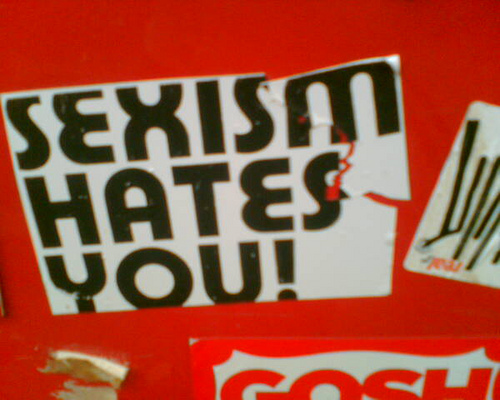The modern day Aussie woman is a phenomena, not a relic

When will all those attention-seeking, headline craving sexist males accept that the modern day woman is not a relic? Nor an object. She is a phenomena.
Let’s face it; the treatment of Australian women from the good ‘old Aussie blokes’ is appalling. No woman is immune. It matters not if they hold the highest office in the land or one far less prestigious. Equally as appalling is the alleged calibre of the perpetrators: those that espouse to be pillars of society. Those who seek respect from others but themselves offer none. It is the public display of sexism from political figureheads or aspirants that disgusts me the most. Do these people realise that their behaviour towards the Prime Minister – clearly a person they dislike – is degrading to most women – not just the Prime Minister – as well as being considered grossly offensive by an equal number of men?
Menugate is the latest in a long line of sexist degradation aimed at the lady at the top. Just being a woman with a job makes her vulnerable. She should be at home ironing.
It seems that some hold old values that not only demean Australia women but pretend to know what their place should be in our society; both economic and cultural.
Tony Abbott, for example, is one of those.
He had his audience in raptures a year or so back with his comment that women should stay home and iron, or something to that effect. Although the laughter has died down, the image has not. It is an image that was all too familiar in this country: the barefoot and pregnant housewife. There’s nothing like a good old fashioned stereotype to remind women of their subordinate roles.
He never retracted that comment, which suggests he still carries that ideology. His ideology is stupid and out of touch with reality. He is not alone, however, as we have seen recently.
Mr Abbott is a fool if he thinks the modern day woman wants to stay home and iron, and a bigger fool for saying it. His party faithful and media friends have displayed equally breathtaking foolishness over the last week. Women should not be stereotyped, especially into the role model they expect of them. Instead of barking at everybody how the carbon price is going to destroy the universe or the refugee boats destroy our country, try grasping something in the real world. Here’s a start: woman don’t want to stay home and iron. They want to work. They want jobs and careers. They want what their mothers fought for. It’s been that way for 40 years. Try recognising them in today’s world.
A number of reasons could be proposed that explain the prejudice. The obvious is that women are seen as less capable as white Australian males, or perhaps it is a power struggle that excludes women because of the historical social construct of male dominance.
This is where I will discuss why they are a phenomena, not a relic. To do so allow me the liberty of putting on the teacher’s hat and give a history lesson on how they have fought for their rights to work and belong in an environment and society that has always wanted to exclude them. Society wanted them to stay home and iron. But here’s something some people need to wake up to: the modern day woman doesn’t. She wants to be treated as an equal.
And so begins the history lesson.
Not many women had jobs until World War 2. During the war female participation in the workforce was buoyed by the necessities of the time, however, at the conclusion of the war in 1945 the workforce returned to male domination.
Feminists groups could easily considerthat capitalists, unions and governments had conspired to discourage employment opportunities for women, and indeed, the unevenness of the gender balance in employment was not seriously addressed until the 1970s. Two significant events that opened up opportunities for women were equal pay and the efforts to remove sexual discrimination.
The gender distribution has also been evened by two other agencies. Firstly, the life expectancy of women has increased as has their availability to work. Secondly, and more significantly, many traditional male jobs have become redundant due to automation, especially computers. Women are now the skilled workers in this new work culture.
The employment nature in 1945 was influenced by the demands of World War 2, creating in Australia one of those moments in history where women were brought into the workforce because their labour was needed and not because of their own desires in the matter.
I could put my head on the chopping block here by claiming his indicates that women were used as only a reserve of labour – and discarded at will – that governments and capitalists have historically maintained the subordination of women in the workforce for capital’s interest.
Whatever the argument, immediately after 1945 the gender composition of the workforce was extremely male dominant. Over the next fifty years this dominance was addressed and moderated.
Without transgressing too far from the issue of gender composition, it is worth considering what my female friends argue is behind the traditional male dominance. Some claim that work conditions had been regulated to exclude women from areas of male dominance, adding that governments pursued policies that have either re-enforced women’s dependant position in the home or locked them into dependency on welfare. The Australian labour force was highly segmented against women. There was a huge gap in inequality of employment (that would delight Mr Abbott and his ilk), being:
- differences in access opportunities;
- differences in job tenure and security;
- segregation within jobs and industries; and
- differences in earnings and benefits.
From 1947 a steady growth in the percentage of women in the workforce has been recorded. Possible causes of this growth in women’s labour force participation can be attributed to the following events:
1949: Female pay rate fixed at 75% of male rate
1949: Women admitted to the Australian Public Service
1966: Abolition of Marriage Bar in the Australian Public Service (married women now able to be permanently employed)
1972: Equal pay for work of equal value
1984: Sex Discrimination Act
1986 also is significant as the federal government introduced the Affirmative Action Agency to administer the Equal Opportunity for Women Act due to continuing concern in the workforce participation and income disparities between men and women.
If women had been deliberately kept from the workforce, then this period represents a push for employment opportunities. Up to the 1960s in particular, women were considered mentally, physically and intellectually inferior to men and thus unable to perform men’s traditional tasks. Since the 1970s, feminist’s movements have won new freedoms for women. The right to work has been one as has equal pay for equal work.
Given the steady increase in female participation in the workforce it indicates that the gradual introduction of equal pay/opportunities and the removal of discriminatory practices have affected gender distribution.
But there is another dimension: the social factor, that is, the opportunity to be able to seek employment. Contrasting a woman born in 1945 with the scenario of that of the particular woman’s grandmother, on average, the grandmother married when she was aged twenty-five, had her last baby when she was forty, and died aged not quite sixty. By contrast, her granddaughter married when she was aged twenty-two, had her last child when she was thirty and expected to live on to seventy. In other words, the granddaughter would have at least twice as many years to work after her last child went to school as did her grandmother.
The social factor is also considered important. Steadily over the past fifty years the working woman, and in particular the working mother is a more familiar role than prior to World War 2, as are the socialisation processes that working encourages. Without work it is difficult to participate in community life, and this is reflected in women’s increasing participation in work as an explicit response to their marginalisation in society.
Gender differences in the workforce are now also influenced by economics rather than political or social factors.
There has also been a massive change in the nature of the Australian labour force. Whereas most people had been employed in the primary sector (farming and mining), secondary industries (manufacturing), and in tertiary (service), the last fifteen years has witnessed growth in the quaternary (information processing) services.
Male job displacement had a very humble start. The introduction of the typewriter brought women into the workforce at the expense of men writing by hand. It was only natural from there that women progressed to computing and other clerical or office positions.
Workplace discrimination against has decreased significantly since 1972. That year saw the introduction of ‘equal pay for equal work,’ and the Sex Discrimination Act (1985) further provided women with greater employment opportunities. Minority groups have also benefited from various State and Federal anti-discrimination initiatives. However, evidence suggests that discrimination exists beyond equal pay and equal employment opportunities. This is an issue for concern as over seventy percent of all complaints lodged with the Commissioner for Equal Opportunity are about discrimination in employment.
Despite the changes in the social context of society, there still exists a degree of negativity towards working women. I’ve heard mention of a ‘glass ceiling, or wall of subtle discrimination’ as a barrier to jobs or career advancement, while a more feminist’s view would suggest that women’s experiences are associated with oppression in the power structure. Both these have merit, whilst others would argue that work conditions have traditionally been regulated to exclude women from areas of male dominance.
Other views are less ‘radical’, suggesting that males assume they are less interested in the job and more tied to their family, such as staying home and doing the ironing. These ‘familial ideologies’ that place women into a ‘narrow band of expectations’ which oppresses them, has not disappeared into history, but lives on in the likes of Tony Abbott and his pack of loyalists.
Well, there’s my take, a simple view from a male. We have evolved into a society where women are now major players on the employment, economic, political and social landscapes. We need them there. We would collapse without them.
Don’t be surprised if the modern day woman doesn’t want to stay home and iron. They might prefer to keep what they’ve fought for.
So please, show them some respect. It’s not man’s world … anymore. Women own it too. They don’t deserve to be treated like they were in our grandparent’s day, a relic to put on a menu or to stay at home doing the ironing.
The modern day Aussie woman is a phenomenon of the times. Our times.
Like what we do at The AIMN?
You’ll like it even more knowing that your donation will help us to keep up the good fight.
Chuck in a few bucks and see just how far it goes!
Your contribution to help with the running costs of this site will be gratefully accepted.
You can donate through PayPal or credit card via the button below, or donate via bank transfer: BSB: 062500; A/c no: 10495969










